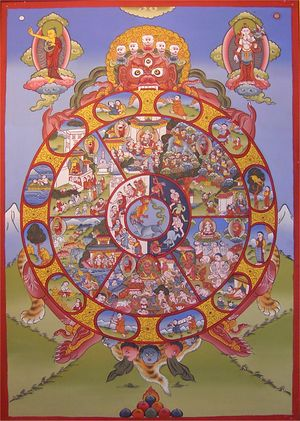Samsara

Samsara (Sanskrit: m., संसार saṃsāra, literally: "constant wandering"), the wheel of rebirth (cf. Gilgul Neshamot, Hebrew: גִלְגּוּל נְשָמוֹת in the Kabbalah), is the name for the everlasting cycle of being, the cycle of becoming and passing away, in the cycle of rebirth.
This eternal cycle is considered suffering in the Eastern religions (Hinduism, Buddhism and Jainism). Breaking out of this disastrous cycle is achieved by letting go of all attachments, desires and wishful thinking, and through enlightenment. The state of "salvation", of eternal bliss, is achieved, which the Hindus call moksha and the Buddhists nirvana.
Samsara is vividly depicted in the so-called wheel of life (Bhavacakra), which is widely used in Tibetan buddhism. In the centre, around the hub, the driving forces of the wheel are represented, so to speak, the three poisons of the mind: delusion, hatred and greed, as a pig, a snake and a rooster. The pig symbolises ignorance, the snake hatred and the rooster greed. Following this, the result of actions based on the mind poisons is shown as descending path black, the path of overcoming these mind poisons is shown as ascending path white. These paths lead to the six possible rebirth realms shown on the next level: White (from top to bottom): gods (devas or suras), (asuras), humans. Black (from top to bottom): animals, hungry ghosts (pretas), hell beings. Here the extent of suffering increases continuously from the god realm downwards to the extreme experiences of suffering and the various hell realms (cold, hot, great hells).
The human form of existence is best suited to reach nirvana, because as a human being one experiences neither excessive suffering nor excessive happiness. In a god form of existence, the sense of happiness is so strong that one will see no reason to break out of this existence in samsara. In a form of existence as an animal, one does not have the necessary mind to break out of samsara, and in a form of existence as a hungry ghost or hell being, one has difficulty doing so because of the predominance of suffering.
In the outer realm, the 12 ways of dependent arising are depicted figuratively, where non-knowledge (Sanskrit "avidyā", Pali "avijjā") stands at the beginning/end of the entire cycle.
